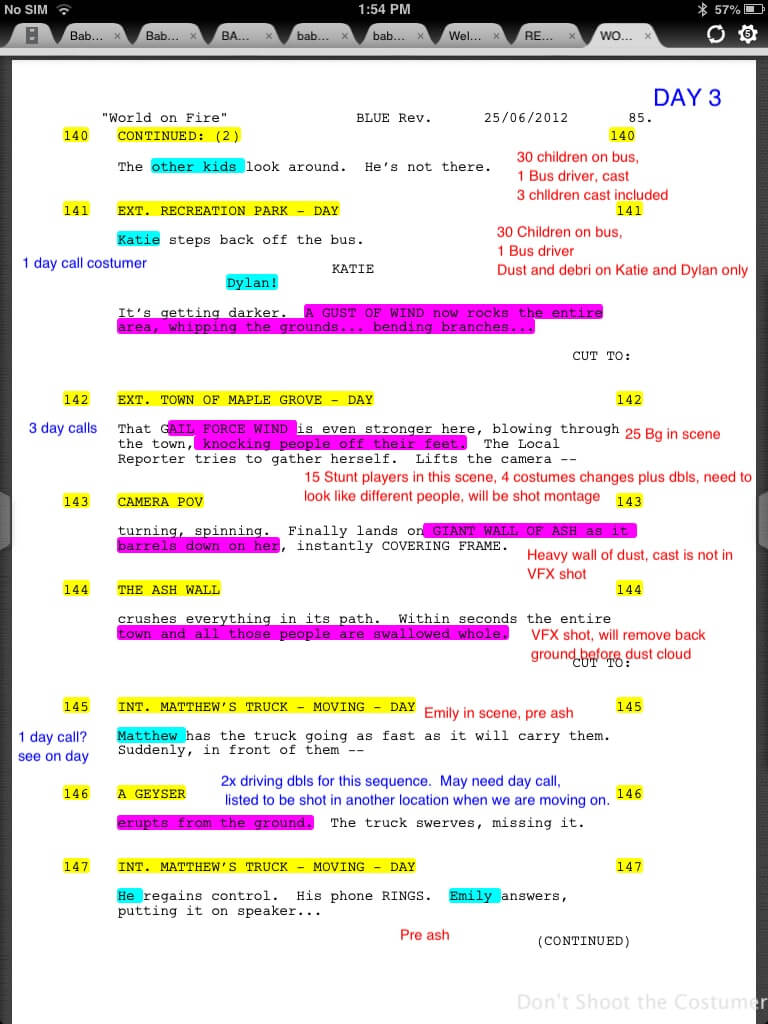
- FINAL DRAFT TAGGER TO MOVIE MAGIC SCHEDULING UPDATE
- FINAL DRAFT TAGGER TO MOVIE MAGIC SCHEDULING SOFTWARE
The first step requires numbering the script’s scenes.

It is “locked” meaning page and scene numbering will not change. This is a specific format with formatting requirements for revisions. The first step is transforming your screenplay into a “Production Script” or “Shooting Script”. You need to use the ‘ quotes if there’s a space in the sheet name.So refer to another cell from another sheet via the name =’Sheet1′!E12 “!” after a string tells Excel it’s a sheet.
FINAL DRAFT TAGGER TO MOVIE MAGIC SCHEDULING UPDATE
When you drag out the cell into other cells it won’t try and update the column or row (depending on which has a $ sign).
FINAL DRAFT TAGGER TO MOVIE MAGIC SCHEDULING SOFTWARE
Software like Final Draft provides enormous complexity, but sometimes the simplicity of something like Highland makes writing more enjoyable.Įntertainment Partners (“EP”) purchased Movie Magic scheduling, budgeting, etc. Knowing the basics of Microsoft Excel or “Google Sheets” is a basic life skill. There’s “industry-standard” software used in major motion pictures, but we’ll focus more here on doing the most with the least. This can be done manually with printed sheets or via spreadsheets. Lay your scenes into a stripboard for scheduling. Google Tasks can be assigned due dates that appear on the calendar.Calendars can be imported to or exported from Google.The sharing features of Google calendar work well for small media productions. Movie Magic Scheduling Google Calendar For Scheduling A production board is not to be confused with a Stripboard used for electronics prototyping.Ī modern version of a strip board will commonly be printed using dedicated computer software, such as MovieMagic Scheduling, Celtx, or Scenechronize, or by customizing general purpose software such as Calc or Microsoft Excel. For logistical purposes, scenes are often grouped by talent or location and are arranged to accommodate the schedules of cast and crew. This is done because most films are shot “out of sequence,” meaning that they do not necessarily begin with the first scene and end with the last. The strips can then be rearranged and laid out sequentially to represent the order one wants to film in, providing a schedule that can be used to plan the production. Reports, like the DOOD (a “Day Out Of Days” report that tracks when talent is working) can be generated from these breakdowns.Ī traditional production board, stripboard, or production strip is a filmmaking term for a cardboard or wooden chart displaying color-coded strips of paper, each containing information about a scene in the film’s shooting script.(As a general idea, 5 pages per day is generally shootable and each of those pages could be a minute of screen time.) Each 1/8″ of a page is considered an “eighth”. Divide every page into eight 1-inch parts and figure out how many eighths each scene occupies.Most of the script and production computer software out there comes in both Microsoft and MacOS versions, and even though there is competing software on the market, these which are listed are considered to be an entertainment industry standard.” – Wikipedia This information can easily be imported over to Movie Magic Scheduling to create a digital production board, and then easily imported over to Movie Magic Budgeting to create the entire production budget. This process is more easily done nowadays utilizing a computer than done manually, with features inside Final Draft called tagger, or utilizing tagging mode inside Movie Magic Screenwriter, another effective computer program.

“After which, these highlights are then organized and broken-down into strips to organize the production schedule within the actual physical production board. You will not be shooting your film in screenplay order.

It also makes it easier to schedule things, like talent, in a way that’s cost effective.

so that you don’t show up to set without something you’re going to need. This is the process of going through the entire script and “tagging” all talent, props, wardrobe specifics, stunts, etc. On your own without a 1st AD or producer you get to do this job. Though I like to do it with software, there are some who still do it manually. On a feature film, this is a huge task, and the groundwork necessary to make the overwhelming logistics manageable. Let’s look at physically realizing what, until now, has been no more than ideas written on paper.


 0 kommentar(er)
0 kommentar(er)
